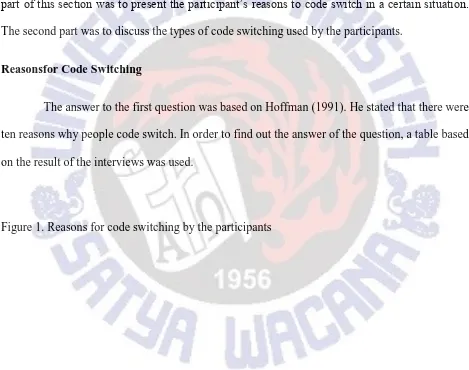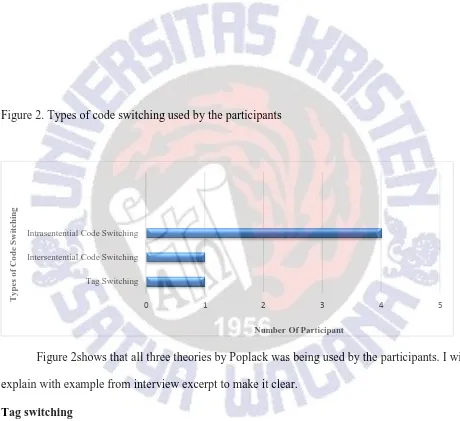FINDINGS
The findings were presented using tables to answer the two research questions, (1) why EFL learner code switched in certain situation, (2) what are the types of code switching used by EFL learner.
The findings were organized by answering the two research questions above. The first part of this section was to present the participant’s reasons to code switch in a certain situation.
The second part was to discuss the types of code switching used by the participants.
Reasonsfor Code Switching
The answer to the first question was based on Hoffman (1991). He stated that there were ten reasons why people code switch. In order to find out the answer of the question, a table based on the result of the interviews was used.
From the figure 1, it can be concluded that there were five reasons used by the participants when they code switched. Each reason used by the participants would be explained with the dialogue excerpts to make it clear.
Expressing group identity
All five participants used code switching to express which group they belonged to. In their daily life as a student of English department, it was common for them to speak English both inside and outside of the class. So it was common to see English Department student to code switch between their first language and English. For example,
Excerpt (1)
A : Dengan siapa? B : My name is Agus
The writer used Indonesian language to begin the interview. When the participant wanted to introduce himself, instead of answering nama saya adalah Agus, he used English. He wanted
1 2 2 1
5
Talk about particular topic Quote somebody else Feel emphatic about something
Interjection and inserting sentence fillers or…
Repetition used for clarification Clarifying the speech content for interlocutor Express group identity Soften or strengthen request or command The need of real lexical
Exclude other people when a comment is intended…
0 1 2 3 4 5
R ea so n w fo r co de sw itch
to express his group identity as an English Department student.Gardner-Chloros (2009) stated that participants of a specific community often used two languages in the same conversation, because they were expressing which group they belonged to.
Clarifying the speech content to interlocutor
Another reason which occurred was clarifying the speech content for tointerlocutor.It occurred in one interview with the participant. One of the participants wanted to clarify the price of his product as seen in the excerpt 2.
Excerpt (2)
A : Terus, aaaaaa harganya untuk dexon per botol itu berapa?
B : Well, the prize is just Rp 75.000. It’s for non-member and the member just lima puluh ribu rupiah.
A : Jadi harganya itu Rp. 55 ribu untuk yang member? B : Fifty thousand
A : Ooooo, 50 thousand untuk yang member dan 75 ribu untuk yang non-ember, gitu ya?
B : Yes of course.
From the excerpt 2, the participant used English fifty thousand to clarify the price of dexon because the researcher did not understandclearly what the participant had said. Hoffman (1991) stated that when people wanted to clarify their speech, they clarified a message to make the conversation run smoothly.
Repeating meaning for clarification
The third reason for code switching wasrepeating meaning for clarification.This reason was used by two participants. The example can be seen in excerpt 3 and excerpt 4.
A : Terus mbak punya solusi apa nih supaya SIASAT di FBS bisa menjadi lebihbaik untuk kedepannya?
B : I think , menurut saya sih, FBS harus menyediakan tambahan kelas atau tambahan dosen lagi sehingga tidak ada kasus dimana mahasiswa harus begging for class, memohon-mohon kelaslagi. That’s it.
Excerpt (4)
A : Begini mbak, sebagai mahasiswa yang notabene angkatan tua nih ya, kegiatan mbak apa sih?
B : Kegiatan saya sih tinggal skripsi mas, sama buka toko parfum kecil-kecilan. Lumayanlah mas buat side job daripada nganggur.
A : Wah sepertinya menarik ini usaha yang mbak lakukan, bisa diceritakan kepada saya mbak sistemnya?
B : Ya cuma refill parfum, pengisian ulang itu lho mas
Hoffman (1991) stated that when a bilingual wanted to clarify his or her speech to a listener, sometimes he or she used both languages that he or she mastered. The purpose of using both languages was to explain and emphasize about something.
The two participants in excerpt 3 and excerpt 4 repeated two words which had the same meaning; I think-menurut saya, begging-memohon, refill-isi ulang. The participants used both languages to make it clear to the listener about what they meant.
Getting attention using interjection
According to Hoffman (1991), Interjection is a words oran expressions which people use
to show their emotion or to gain attention, such as; Darn!, Hey!, Well!, Look!, etc. Two
participants used this reason to code switch. Excerpt 5 is the interview excerpt from one of the
participant.
Excerpt (5)
The participant used interjection inwell, belakang kampus persis to gain my attention when she wanted to show the location of her store to make the researcher’s attention focused on
what she said next.
Talking about a particular topic
According to Hoffman (1991), people prefer to talk about a particular topic using their
first language as main language and slip some words to express something which they cannot
express when they used their first language. Only one participant used this reason.
Excerpt (5)
A : Ahahaha, kok bisa deg-degan gitu mas?
B : Lha coba bayangin mas. Ketika saya butuh kelas A, saya harus rebutan apa itu namanya, aaaaa, nah iya class seat dengan mahasiswa yang lain mas.
It was a very clear example of code switchingbecause the participant could not expressthe word kursibecause it was common for English Department students to use the term class seatinstead of kursi when they referred to SIASAT seat avaibility. As a result, the participant code switched from Indonesia to English when the participant could not express the word kursi and replaced it with class seat instead which the participant was familiar with when they do SIASAT.
Types of Code Switching the Participants Used
tableto show the types of code switches and which type was used by the participants based on the interview conducted.
Figure 2. Types of code switching used by the participants
Figure 2shows that all three theories by Poplack was being used by the participants. I will explain with example from interview excerpt to make it clear.
Tag switching
According to Poplack (1991), tag switching is the simplest types of code switching because it only related to the use of tag (e.g. you know, I mean, right, etc). The example of tag switching occurred while I did the interview with two participants. The excerpt 6is an example. Excerpt (6)
0 1 2 3 4 5
Tag Switching Intersentential Code Switching Intrasentential Code Switching
Number Of Participant
Ty
pes
o
f
C
o
de
Sw
itch
in
A : Mas, dulu apa sih yang menyebabkan mas kok daftar di FBS UKSW?
B : Hmmmm, nganu sih mas, daridulu kan memang saya sangat suka mempelajari bahasa inggris, dan memang bahasa inggris di UKSW itu lulusane sudah terkenal dan dicari. I mean, fresh graduate dari UKSW itu lebih gampang mencari kerjaan gitu mas kalau saya liat di lingkungan saya.
The excerpt 6 was a clear example of tag switching. The participant used the simple tag word I mean when the participant talked to the researcher.
Intersentential code switching
Intersentential is a second theory proposed by Poplack (1991), which occurred in phrase and sentence level. The participant below used intersentential code switching when he talked with the researcher, such in excerpt 7.
Excerpt (7)
A : Aaaa, terus. Kalau saya ingin beli, belinya itu dimana?
B : Well, you can just ask me to buy the product atau bisa hubungi di nomer 085641856401
Intrasentential code switching
According to poplack (1991), intrasentetial code switching is the most complex type of code switching. Thecomplexity of this type of switching is explained by the high probability of violation ofsyntactic rules, as well as the requirement of a great knowledge of both language grammars which are their first language and English as theirforeign language. Most of the participant of the study used intrasentetial when they code switched. Let’s see one clear example
of intrasentential code switching in excerpt 8 and excerpt 9.
Excerpt (8)
A : Oke mbak Indah, jadi menurut mbak itu sistem SIASAT di FBS gimana? Pasti sudah pengalaman donk soal SIASAT?
B : Sistem siasat di FBS ya, hmmmmmm. Menurut saya sih it’s not bad lah, tapi kadang-kadang it makes us depressed. Pasti tau lah mas kan kalau SIASAT harus rebutan sama yang lain juga, jadi banyak mahasiswa yang takut jika mereka tidak dapat kelas.
Excerpt (9)
A : Begini mbak, sebagai mahasiswa yang notabene angkatan tua nih ya, kegiatan mbak apa sih?
B : Kegiatan saya sih tinggal skripsi mas, sama buka toko parfum kecil-kecilan. Lumayanlah mas buat side job daripada nganggur.
intrasentential code switching. The first excerpt showed that the participant used a lot of code switching in one sentence, while the second excerpt showed a simple code switching in one sentence. The complex intrasentential code switching required vocabulary knowledge both in bahasa Indonesia and English.

